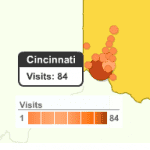Learn how to use Google, Analytics and AdWords to make your marketing the Greenest ever – Paperless and with trackable ROI. Seminar is offered by Lohre & Associates, Inc. Marketing Communications, parent company of Green Cincinnati Education Advocacy.
It starts with knowing how your customers find you on the web. In this 2 hour seminar, you’ll take away your own Google Local account, Google Analytics account and Google Ad Words account. With these tools you can leverage future marketing tasks and improvements to existing sites.
Call us if you don’t come up above the fold on Google after doing these five things:
1. Put your keywords in the URL, “Dynamic Braking,” http://www.postglover.com/dynamicbraking.html
2. Put your keywords in the page title, “GyraMax Gyratory Sifters,” http://www.sweco.com/sifter_gyratory.html
3. Put your keywords in the page headline, “Allis Chalmers,” http://www.aepump.com/
4. Use your keywords as link text in the body copy, “Milford Ohio Roofing,” http://www.guaranteedroofingohio.com/Milford-Ohio-Roofing.htm
5. Use you keywords as an alternative text for a photo on the page, “Integrally motorized spindles,” http://www.skfpt.com/spindles.html
Or call us first and you won’t have to worry about it.
Testimonial, “We live in a world where search engines are constantly changing the way they view and rank websites. Chuck’s ability to stay on top of these regulations and keep us at the top in our major keyword search categories has eliminated any anxiety that trying to stay versed on search engine optimization can cause. Thank you for doing a great job for us!” Jeff Dierig, Manager of Marketing Services, SWECO.
Seminar outline: Interactive Media, Internet Tips
Top ten tips for free natural search engine web site promotion listed in order of importance:
- Find keywords by searching for competitors’ websites in either Yahoo, MSN or Google, adding the word “related:” before their URL. Example: related:www.insert competitor’s URL here.xxx
- Install Google Analytics and study what keywords visitors used to find your site.
- Write the URL (with dashes in between words), title, description, headline, first paragraph, alt tags and link text using those words. Use the full URL address on your links.
- Have an informative HTML site that keeps the reader engaged so he will bookmark or add your site to his favorites list as a resource. Make the site a resource guide. Write technical articles or presentations for the trade and publish these articles on your site.
- Submit your site to Open Directory http://www.dmoz.org.
- Submit a site map to Google, Yahoo and MSN.
- Add a blog to your home page and edit it once a week or so.
- Get links to your site at the same places your competition does. Find these places by searching for a competitor’s website, adding the word “link:” before their URL in the search field. Example: link:www.insert competitors URL here.xxx. Consider requesting a link on the same site where your competitor has a link only if that site ranks 4 or better in Google.
- Every month search Google for 5 keyword phrases, make changes to your site to improve rankings.
- Study your keyword usage at http://www.indextree.com/seo-tools/keyword-research.php

Top ten tips for paid search engine web site promotion listed in order of importance:
- Test to see if it has any effect for your market.
- Don’t pay too much for ad words if you are ranking high naturally. Probably 80% of your traffic comes from natural search anyway.
- Google, Yahoo and MSN programs will generate over 80% of your sponsored visitors. Focus on only the direct search functions through the SE’s program first. Don’t use content partners or content matches. They can triple your costs and you don’t know where visitors found you. Later with more experience you can experiment with them.
- “Spend budget until depleted” with MSN. Don’t set to spread out. You won’t be able to properly see your listing if the SE is hiding it to wait until later in the month. Use bidding and daily maximums to limit expenses. Set your individual keyword bid low enough to meet your budget but not go over your daily maximum.
- Add conversion codes to your site: Yahoo’s code goes in between the <head> tags; Google’s code goes between the <body> tags, closer to the </body> tag; MSN’s code goes between the <body> tags at or near the lower-right corner of the page so that it does not detract from your page design.
- With Google limit your expense with monthly budgets and keyword bid maximum, “xxx” and – (negative) keywords. You need to think of every possible way a visitor may use your keywords and put it and the modifer in “quotes.” Without quotes, Google will display your ad in places were you don’t want those visitors. Use negative “-” keywords to limit those. Create unique ads that improve your quality score but that will only limit your cost by about 20%. Lastly, limit the display of your ads to 4 am to 8 pm for North America. Funny, some how all of your budget gets spent at 1 am. The SEOs have stopped refunding for click fraud. Remember, you’re communicating with an algorithm not a human.
- With Yahoo limit your expense with monthly lower bid. limit the credit card charge amount to get a notice of too high spending activity.
- With MSN limit your expenses with monthly budgets and maximum bid.
- Pay attention to the words that get clicked on. Pay closer attention to words that convert.
- Fine tune your ads to convert and try to find out if conversions result in sales since industrial conversions are for going to the contact page or sign in page for more information or a sales rep visit.
(11-30-19 301 redirect made)
